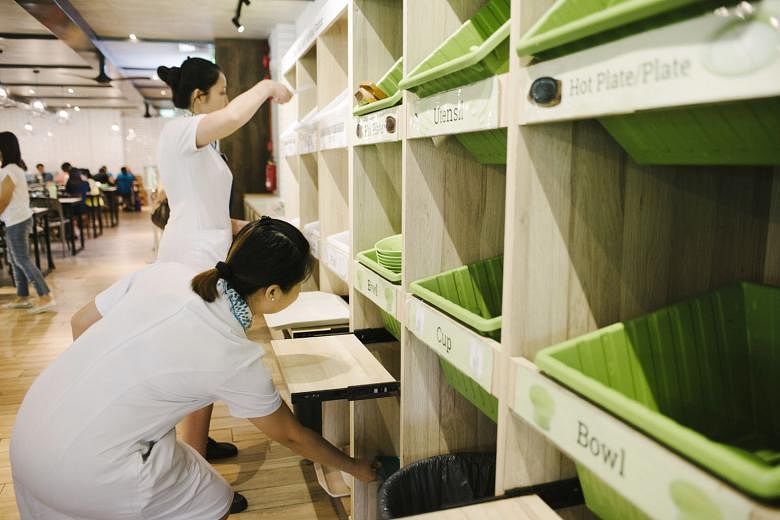Forget to pick up your tray at this hawker centre, and you might find yourself picking up bad vibes from fellow diners.
Such behaviour is frowned upon - literally - at Khoo Teck Puat Hospital (KTPH), a tactic which has helped its hawker centre lift its tray return rate from 20 per cent to 70 per cent, all without dangling discounts or implementing deposits.
Customers do not just take their trays to the racks after a meal. They must also sort their used crockery and utensils. And if they fail to do so, they might receive the occasional unwelcome glance.
The hospital's chief operating officer, Ms Yen Tan, explained to The Straits Times how three factors have helped it to achieve what many eateries are striving to do: "Leadership by example, cues to discourage undesirable behaviour, and helping those in need such as the elderly or the immobile.
"For example, when a staff member sees a patron not returning the tray, he or she will give a subtle frown. We observed that in most instances, patrons will take the cue and return their trays."
Dr William Wan, general secretary of the Singapore Kindness Movement, said people tend to follow the crowd around them. "If the majority of the hawker centre patrons do not take the initiative to return trays after their meals, the others will not feel compelled to be 'outstanding' and do the right thing by returning trays," he said.
At KTPH, design was also an important factor. Tray return areas are centrally located and easily accessible. Said Ms Tan: "Our intuitive sorting system is also designed to make it easier for patrons to sort their crockery and discard their leftovers in the bins.
"This helps improve the overall cleanliness of the foodcourt and boosts productivity as manpower can be redeployed to other areas."
When The Straits Times visited KTPH hawker centre at lunchtime yesterday, most people were seen returning trays and sorting crockery. Despite the crowd, there were no lines at the tray return area, which was also clean and odourless.
Ms Annie Teo, 41, was one of the diners who returned her tray yesterday. The associate human resources director said she did not find it a hassle to return her tray and sort her crockery, adding that everything was clearly labelled.
Ms Teo said she always returns her tray when she dines out, but noted: "This is a better scheme to encourage tray return compared with charging deposits for trays, which some people may not like."
Despite mixed reviews of tray return systems involving incentives or disincentives, figures show that they do work. At the hawker centre in Our Tampines Hub, for example, diners earn reward points that can be redeemed for free items, such as drinks, for every tray returned.
There, the tray return rate averages between 60 and 70 per cent, according to a spokesman for Kopitiam, which manages the centre.
Food hall Timbre+ in one-north, run by the Timbre Group, charges patrons a refundable $1 deposit for each tray. A spokesman said the system has allowed it to achieve a return rate of 97 per cent - the national average is 20 per cent.
She said the system enables a faster turnover of tables, allowing customers to get clean tables quicker. "There are also fewer pests such as birds, which tend to nibble on leftovers, and it allows for a cleaner and pleasant dining experience," she said.
Dr Wan is confident Singaporeans will eventually develop a tray return culture, though these changes will not happen overnight. He said: "We are approaching the tipping point where we will see a positive shift in Singapore's society."

